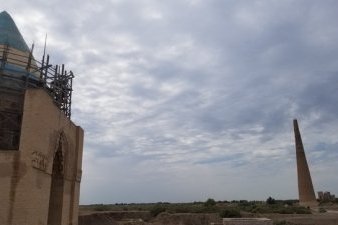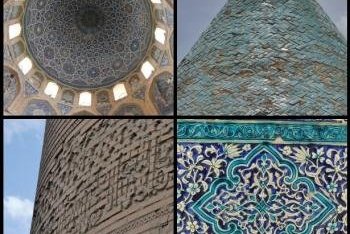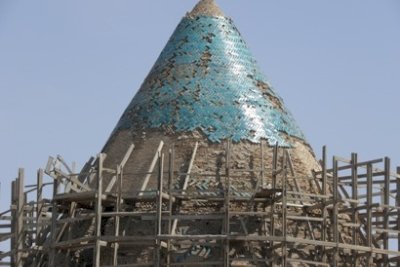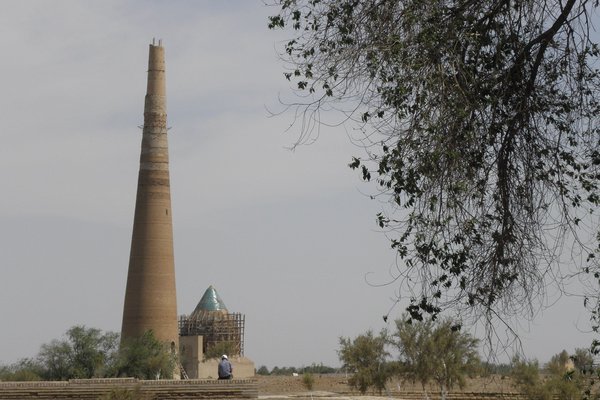Turkmenistan
Kunya-Urgench
Kunya-Urgench covers the remains of a major trade center on the Silk Road and the capital of the Achaemenid Khorezm region.
The archeological site contains many ruins of monuments from the 11th to 16th centuries, including fortresses and a 60m high minaret. Its distinct decorative style and architecture, such as dome constructions, have influenced buildings in Iran, Afghanistan and the Mughal Empire. The place is also still a place of pilgrimage.
Community Perspective: this site is on a more manageable scale than Merv, there's a footpath that links the monuments and “the atmosphere of semi-desolation in the desert does have a certain appeal”. Solivagant particularly enjoyed the area where local people came to pray for fertility. Clyde found the Mausoleum of Turabek Khanym and its tiling the absolute highlight.
Site Info
Official Information
- Full Name
- Kunya-Urgench (ID: 1199)
- Country
- Turkmenistan
- Status
-
Inscribed 2005
Site history
History of Kunya-Urgench
- 2005: Inscribed
- Inscribed
- Type
- Cultural
- Criteria
- ii
- iii
Links
- UNESCO
- whc.unesco.org
All Links
UNESCO.org
- whc.unesco.org — whc.unesco.org/
Community Information
- Community Category
- Religious structure: Islamic
- Archaeological site: Near Eastern
- Secular structure: Burial
Travel Information
Recent Connections
-
Perfect Inscriptions
2005 -
Mongol Invasions
"the Khorezm capital that rose to great… -
U.S. Ambassadors Fund
Restoration of a Majolica Tombstone in …
Connections of Kunya-Urgench
- Individual People
-
-
Ibn Battuta
"it ... was described in the 14th century by the Arabic traveller Ibn-Battuta as 'the largest, considerable, beautiful and majestic city of Turks with fine bazaars, wide streets, numerous buildings and impressive views'." (nomination file)
-
- Trivia
-
-
On Banknotes
Monument of Torebeg Hanum; 500 manat; 1995
-
- History
-
-
Located in a Former Capital
Capital of Khwarezmia 1077-1221 -
Silk Roads
Classic Land Route; trading centre and caravanserai (wiki)See en.unesco.org
-
Mongol Invasions
"the Khorezm capital that rose to great prominence between the 10th and 14th centuries, before being destroyed by the Mongols" (OUV) -
Achaemenid Empire
Urgench was the capital of the Khorezm region, part of the Achaemenid Empire -
Golden Horde
"In 1321, the town was annexed to the Golden Horde" -
Khorezm empire
First capital -
Seljuk Empire
was a major centre of Khorezm, ruled by the Seljuk dynasty (AB ev)
-
- Architecture
-
-
Conical roofs
-
Glazed tiles
-
Brick architecture
Gutluk-Temir Minaret
-
- Damaged
-
-
Destroyed during invasion
Genghis Khan 1221
-
- World Heritage Process
-
-
Perfect Inscriptions
2005
-
- Religion and Belief
-
-
Notable mosques
Dash mosque -
Sufism
"Najmeddin Kubra Mausoleum The holiest place in Kunya Urgench - Najmeddin Kubra was a famous teacher and poet who founded the Sufi Kubra order". There are 2 tombs inside - one for his body and one for his head, which were separated when he was killed by the Mongols in 1221.
-
- Constructions
-
-
Notable minarets
Kutlug-Timur Minaret, 60m high -
Caravanserai
Unknown building that is possibly a caravanserai -
Mausolea
Najmeddin Kubra Mausoleum
-
- WHS on Other Lists
-
-
U.S. Ambassadors Fund
Restoration of a Majolica Tombstone in the 14th-Century Mausoleum of Najm-ad-Din al-Kubra in Kunya Urgench (2011), Restoration of the 11th-Century Ak-Saray-Ding Tower near Dashoguz (2005), Restoration of the 12th-Century Sultan Takesh Mausoleum Dome (2005)
-
- Timeline
-
-
Built in the 11th century
Kutlug-Timur minaret dates from the 11th century
-
News
No news.
Recent Visitors
Visitors of Kunya-Urgench
- Adrian Turtschi
- Ali Zingstra
- Ammon Watkins
- Ana
- Artur Anuszewski
- Ask Gudmundsen
- bergecn
- Bill Maurmann
- Bram de Bruin
- Cheryl
- Cirene Moraes
- Clyde
- David Marton
- Els Slots
- Eva Kisgyorgy
- Fernweh
- Fmaiolo@yahoo.com
- Gernot
- Harald T.
- Harry Mitsidis
- henryjiao18
- Iain Jackson
- Ingrid
- Ivan Rucek
- Janos
- Jean Lecaillon
- JoshHad
- KarenBMoore
- Kevin Padley-Knight
- Knut
- Ludvan
- Luis Filipe Gaspar
- Maciej Gil
- Martina Rúčková
- Mihai Dascalu
- Mikko
- Milan Jirasek
- Philipp Leu
- Pieter Dijkshoorn
- Piotr Wasil
- Roman Bruehwiler
- Solivagant
- Szucs Tamas
- Thomas Buechler
- Timothy C Easton
- Westwards
- Wojciech Fedoruk
- Zoë Sheng
Community Reviews
Show full reviews
Coming from the north (Uzbekistan) this will be the first site to visit. I honestly did not enjoy visiting here even though the minaret is impressive to stand for long (including Mongolian invasion, earthquake). Most of the site is still under ground, some is still recoverable but it seems they don't want to and UNESCO is against it too.
You'll visit a mausoleum, the minaret, and more mausoleums as you pass through the area. While the first mausoleum is impressive and the minaret definitely is, overall it's not so great.
It will probably be the reason you are coming from Uzbekistan in the first place.
Keep reading 0 comments
I visited this WHS in June 2017. Even though the area is quite big, it is not comparable to Ancient Merv. The different sites are a good example of how some of Uzbekistan's top WHS would look like without restoration. Moreover, the conical cap-like Islamic structures (top right photo) are in a way quite similar to Armenia's and Georgia's monasteries which I found quite striking. It's the mix of architectural styles and beliefs that I liked most in the ancient Khorezm capital as well as the fact that most remains are still believed to be sacred sites by the locals.
The absolute highlight of this WHS is the Mausoleum of Turabek Khanym. It is the largest building in ancient Konya Urgench and its dome holds an impressive mosaic of 365 interlocking geometric tiles that give the appearance of the night sky (top left photo). The number of magnificently preserved arches, niches and tiling suggests time keeping and calendar keeping was kept in mind when building this structure.
This is perhaps Turkmenistan's most important pilgrimage site and all pilgrims come to visit the Nadjm-ad-din Kubra Mausoleum (14th century). This mausoleum is quite similar to the Shah-i-Zinda complex in Samarkand, Uzbekistan but lacks the most of the magnificent turquoise and blue tiles on the mausoleum facades. However, the main tombstone inside has recently been fully restored and cleaned up to its former glory (bottom right photo).
The tallest structure is of course the minaret with its Zoroastrian symbols and Koranic script (bottom …
Keep reading 0 comments
Kunya-Urgench (Old Urgench) in my opinion is the most impressive of the Turkmen WHS. It's a flat, deserted, hot stretch of land dotted with monuments here and there. The wonderful minaret (the oldest of its kind remaining in the world, and one of the highest buildings from its period) draws your attention right away. The adjoining Tekesh Mausoleum is now under construction, but its turquoise conical dome is still visible.
Visiting the site is well organized: there's a footpath that links the monuments. Some of them can be visited inside too, but often they have been taken over by groups of pigeons. Worth mentioning is the Torebeg Khanum mausoleum which has a wealth in mosaics. Those under the dome are put together like a calendar.
What I liked about the atmosphere here is that it still is a local pilgrimage site. You can see stones placed on top of each other for good luck. There's also a spot where little cribs are left by women who pray to become pregnant.
The site is also still littered with graves. This is said to prevent authorities from excavating here. There must be so much more left underground of this once powerful city!
Keep reading 0 comments
It is perhaps a bit surprising that Kunya-Urgenche, the ancient capital of the Khorezm state (see my review of the Itchan Kala), has been inscribed when there are several other nearby Central Asian historic cities which have also been. But I suppose it is no different from the large number of European cathedrals which have succeeded!
If you want to see it you have to run the gauntlet of the Turkmenistan bureaucracy – first to get a visa and then to get in to the country! I have included a section at the end on our hassles in Oct 2004 which may be of interest/use to anyone intending to go! If you still want to visit you will discover a dusty town, some mosques and a few scattered ruins (and virtually NO tourists!):- In particular a very tall and somewhat rickety minaret looking a bit like a factory chimney and various tombs and mausoleums (photo). Some of these (e.g. the Mausoleum of Turabeg Khanym) are considered masterpieces of Islamic architecture of their era and would certainly appeal to enthusiasts. In 1219 Kunya’s ruler rather unwisely ordered the destruction of a caravan from Genghis Khan with the result that Genghis returned 2 years later and laid waste to all the cities of the area! Kunya recovered, but was destroyed again by Tamburlane in 1379 - the atmosphere of semi-desolation in the desert does have a certain appeal.
.
To us however one of the most interesting sights was an area where …
Keep reading 0 comments
